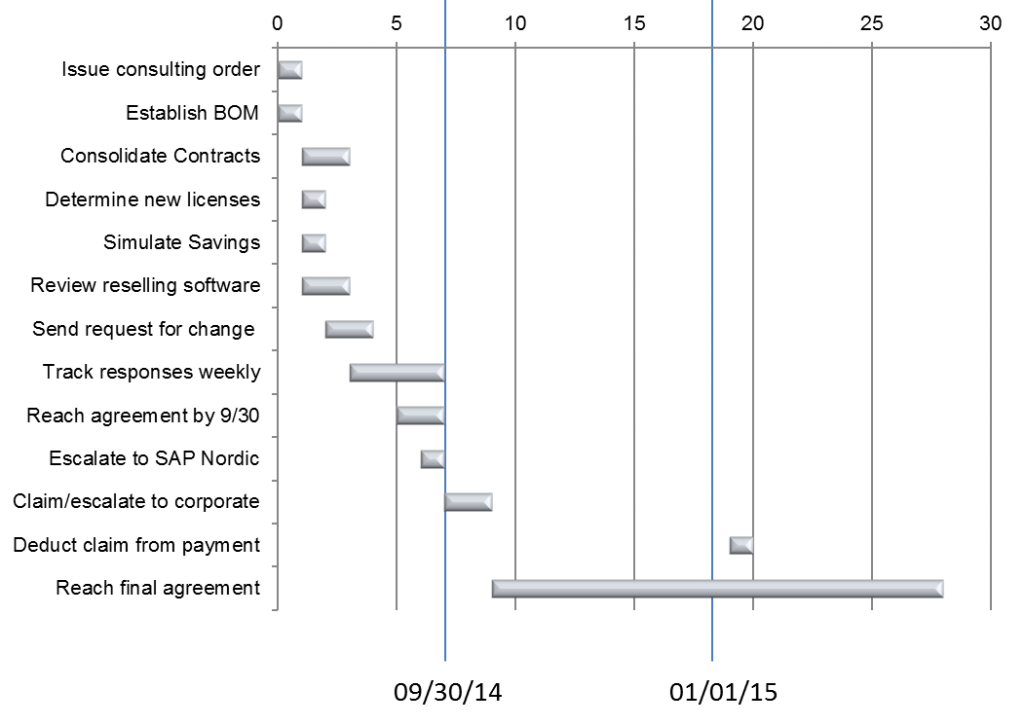Vor allem im Mittelstand ist es sehr verbreitet, seine ERP-Lösung von einem Systemhaus inklusive der Implementierung zu beziehen. Angeboten wird daraufhin ein Gesamtvertrag, der in mehreren Kapiteln die Projektdurchführung beschreibt, die erforderlichen Lizenzen in einem Anhang kurz auflistet und dabei die AGB und Wartungsbedingungen des Vendors nur als Link referenziert. Das erscheint auf den ersten Blick plausibel, weil man sich auf die Umsetzung fokussiert. Das Verfahren birgt aber ein großes Risiko bei der Verhandlung des Softwarelizenzvertrags:
Wichtige Themen, wie Lizenzrabatte, Wartungsdetails, Auditklauseln und Lizenznutzungs- und übertragsrechte werden vernachlässigt!
Was ist zu tun?
Bereits bei der Auswahl der Lösung (z.B. SAP) und der Branchenausprägung über das Systemhaus sollte man sich über die Vertragsgestaltung vorab informieren, und zwar in Form eines typischen Blankovertragswerks. Dieses hat jedes Systemhaus vorrätig.
Das Template gibt man dem Justitiar oder dem Fachanwalt für Vertrags- und Urheberrecht mit dem Ziel, alle werthaltigen Vereinbarungen sorgfältig in die Einzelteile zu zerlegen:
- Allgemeine Beschreibung des Vertragsziels
- Beschreibung des Beraterteams
- Projektleitung mit Verantwortung und Struktur
- Weg vom Sollkonzept zur Lösung, mit Milestones und Abnahmen
- Lizenzstückliste auf Basis der Nutzergruppen und notwendigen Funktionalitäten
- Lizenzangebot mit Erstkondition und Nachkaufkondition
- Wartungsangebot mit SLA und inkludierten Funktionsupgrades
- Projektkontroll-Governance inkl. Eskalationsverfahren
- Behandlung von Change-Requests
- AGB des Systemhauses und des Software-Vendors
Für nötige Verhandlungen der Punkte 5-7 werden in der Regel Genehmigungen des Softwarevendors erforderlich, auf die der Auftraggeber frühzeitig hinweisen sollte, damit Integrationspartner bzw. Systemhaus nicht vor dem Vertragsabschluss auf Zeit spielen und die Regelungen vertrösten. Konkret sollte der Auftraggeber folgende Überlegungen in die Softwarevertragstexte einfügen:
- Beginn der Wartung (Lieferung oder Go-Live?)
- Bestätigung der vollumfänglichen Nutzungsszenarien durch die vorgeschlagene Lizenz-Stückliste
- Kostenloser Austausch von Lizenzen, die sich im Projekt als untauglich erweisen, mit Preisanpassungsklausel
- Inklusion von Funktionsupgrades bei regulatorischen Änderungen durch den Gesetzgeber
- Regelungen des Lizenzportfolios bei End-of-Life/Ersatzprodukten
- Vereinbarung der Art und Häufigkeit der Lizenzvermessung
Weiterer Regelungsbedarf und die juristische Aufarbeiten der Projektthemen sind im gebührenfreien Projektleitfaden von auditprotect zu finden:




